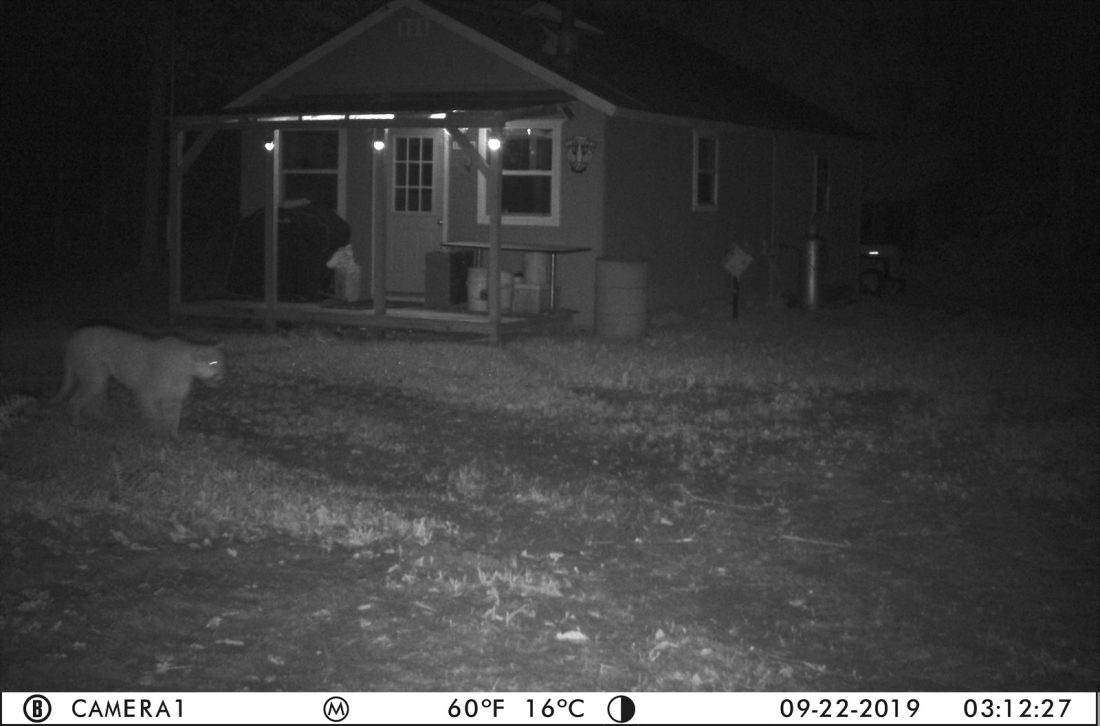Trail cameras reveal cougars
Northwoods Notebook

Landowners near St. Jacques in Delta County captured this trail camera image of a cougar Sept. 22 near a hunting camp.
News that three more cougar photos have turned up in the Upper Peninsula in recent weeks might be viewed as a sign the once-native animal could be making a comeback.
The latest sightings — Sept. 18 and Sept. 22 in Delta County and Oct. 6 in southern Marquette County — bring to five the confirmed photos of the elusive big cat this summer and raises the total number on record since 2008 to 43, according to the Michigan Department of Natural Resources. It’s approaching the high of six U.P. sightings in one year, with two months and deer hunting season still to come.
Yet despite the seeming uptick in cougar encounters, it remains unlikely the cats will become more than a transient presence in the Upper Peninsula or Wisconsin in the near future, said Cody Norton, large carnivore specialist for the Michigan DNR in Marquette.
First, the three cougar sightings in September and early this month could very well be the same animal, given the photos all were within 14 miles of each other, Norton said.
Second, it’s unclear whether the rise in sightings means more cougars roaming the region or the growing popularity of trail cameras to scout game. He thinks it’s a combination of both.
More significantly, Norton said, the DNR has yet to have any conclusive evidence any of these cougars are female — an essential component to having a breeding population in the Upper Peninsula.
Out west, mature male cougars will establish a territory that allows several females to remain but, not surprisingly, will not tolerate other males.
That forces young males to go wandering — or disperse — to find an area not claimed by a larger male. Young females, however, do not need to travel nearly as far to be accepted as a potential breeding partner.
Among wolves, both young males and females must set out on their own, since only the alpha male and female in a pack will breed, with all others in the group expected to assist in raising the pups. So it created a mechanism that could have new breeding pairs of wolves spread from Minnesota to Wisconsin to the U.P.
With no similar dynamic among cougars, for now only males seem compelled to make this journey east — and for some, it has not ended well. One recorded in southcentral Wisconsin in 2008 — it left behind hair that could be DNA tested — ended up shot by police after blundering into suburban Chicago. Another, the only one that had been collared in advance in South Dakota, passed through Wisconsin and the Upper Peninsula in 2009, then managed to reach Connecticut before being hit by a car in 2011; it’s been speculated he covered 2,000 to 5,000 miles.
So while available prey, terrain and a lack of humans would otherwise make the region prime cougar country, until some females follow the males’ path here — crossing three states and countless hazards to do so — the cougar will remain a novelty. It’s telling that Minnesota, a neighbor of South Dakota, has no confirmed breeding cougars in the state.
A number of residents have maintained the animal never really disappeared in the Upper Peninsula, that a small population managed to hang on in the more remote wilderness areas. Again, the possibility is there perhaps a few individuals did manage elude guns and other hazards past 1906, when the last wild cougar was legally killed near Newberry. But over the years, such a small number would suffer from inbreeding, as happened with the wolves on Isle Royale.
The cougars original to the area, too, were the now-extinct eastern subspecies; Wisconsin was thought to have its own subspecies as well. But the two cougars illegally killed in the Upper Peninsula, plus the one killed in suburban Chicago all traced back to the South Dakota population. So far, all of the recent cougars in the Midwest that left behind enough genetic material to be tested have been western cats.
And what of the reported sightings of cougars being trailed by cubs? Norton said the photos presented usually turn out to be bobcats — in some cases housecats — or dogs or some other predator. A few photos had been obviously altered with cougar images from out west.
With visual sightings, “I think there’s a lot of cases where someone sees a flash … and try to convince themselves” they’ve seen a cougar.
But Norton encourages anyone who gets a cougar photo to submit it at the Michigan DNR website, www.michigan.gov/dnr.
Betsy Bloom can be reached at 906-774-2772, ext. 240, or bbloom@ironmountaindailynews.com.


